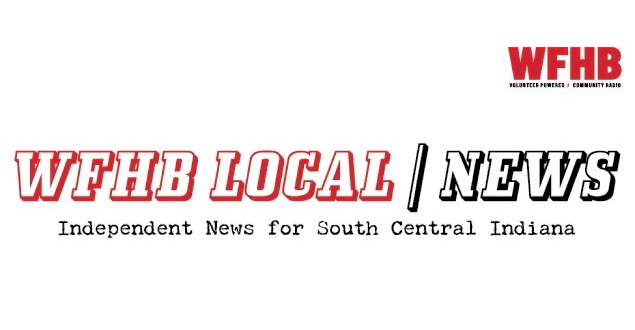Podcast: Play in new window | Download (Duration: 30:10 — 41.5MB)
Subscribe: RSS
This is the WFHB Local News for Thursday, February 3rd, 2022.
Later in the program, residents of Central Indiana are hunkering down to avoid the current winter weather conditions. WFHB Environmental News Correspondent Nathaniel Weinzapfel explains some interesting information about the storm. More in the bottom half of our program.
Also coming up in the next half hour, the Bloomington Music Expo happens this weekend and will feature vinyl records, live music and more. In today’s program, Executive Director of Visit Bloomington Mike McAffee talks about the upcoming music expo. But first, your local headlines.
Local Officials Discuss Pandemic Response at Covid-19 Press Conference

At the Covid-19 Press Conference held on January 28th, IU Health President Brian Shockney, said that the IU Health South Central Region has just had the second highest number of patients on record since the start of the pandemic. He also asked community members to seek out the proper level of care to keep the hospital beds available for those patients who need them the most.
Indiana University Vice Provost of Communications Kirk White reported on the rate of cases of Covid-19 at IU, and announced that they have made masks available to the public.
Indiana University Chief Health Officer, Aaron Carroll answered a question on whether or not the cold weather could affect at-home Covid-19 tests if they are left outside for an extended period of time.
Mayor Hamilton answered a question from Journalist Dave Askins, about whether or not the sanitation department has made changes to allow them to keep working despite the city reporting higher numbers of employees testing positive.
The next Covid-19 Press Conference will be held on February 11th.
Bloomington Utilities Service Board Talks About FOG Program and Covid Sampling at Wastewater Plant

On January 31st at the Utility Service Board meeting, Assistant City Attorney Christopher Wheeler asked the board to approve updates to the rules, regulations, and standards for the City of Bloomington Utilities.
The Fat, Oil, and Grease Program also known as the FOG Program ensures restaurants and businesses know how to properly dispose of their fat, oil, and grease waste.
He said that the rules are not new, however, they are making changes to make sure they are easier to find.
The board approved the changes unanimously.
Director of the Utilities Department Vic Kelson gave a brief update on the Covid samping at the wastewater plant.
The next Utilities Service Board meeting will be held on February 14th.
Residents of Central Indiana are Hunkering Down to Avoid the Current Winter Weather Conditions

Nathaniel Weinzapfel
Hope all you listeners are staying safe and warm out there! As of writing this story, I’m sheltering in my home on the north side of Bloomington, working virtually today. Out my window I can see the peaceful falling of snow in my backyard, with red cardinals interrupting the sea of white.
Coming from a meteorological background, this storm is of particular interest to me. To begin, it is the first significant winter storm of the season. This is of no surprise considering how varied the weather has been in Bloomington. According to information from the National Weather Service’s historical database of Bloomington weather, this last December was warmer than average, especially around Christmas time. While January was slightly colder than average, in terms of precipitation, it was very dry compared to an average year. In total, the amount of snow during the winter months was 0.5 inches in December and 1.2 inches in all of January. To put this in perspective, this winter storm has already doubled the combined total of the 1.7 inches from December and January, and snow continues to fall. Predicted snow depth is likely to reach the ranges of 5 to 7 inches.
One of the conditions that has made this winter storm particularly dangerous, especially south of I-70, was the rain that preceded the colder precipitation. Based on information from the Monroe County Airport data log, which can be accessed through the National Weather Service, it was raining from approximately 4 AM yesterday morning until 6 PM yesterday. There are two key reasons why the rain preceding the snow and ice is a bad thing. The first reason might be quite obvious… that the rain and puddles of water will freeze once it gets colder and create ice. However the second reason is likely what makes it more dangerous. Normally, when meteorologists predict a snow storm, this allows the city of Bloomington to send out a truck with ice salt which can help stop snow from accumulating. But, due to the rain yesterday, this was not possible! If the ice salt was layed down, it would have simply been washed away. This means that the rain will cause both ice and also will not permit any preparation to be done prior to the storm.
Continuing along the timeline, while northern Indiana, including our rivals in West Lafayette, were experiencing snow, Bloomington’s rain slowly transformed into freezing rain. The National Weather Service says that “Freezing rain occurs when the layer of freezing air is so thin that the raindrops do not have enough time to freeze before reaching the ground.” This means that the rain freezes once it reaches the surface of Earth, thus creating an ice layer at the moment of impact. This precipitation began around 7 PM and likely continued until 3 in the morning, at which time the weather data became uncertain. The NWS Monroe County Airport identified “unknown precipitation” occurring between the hours of 3 AM and 9 AM. Part of this was likely due to the weather conditions being a mix of snow, sleet, and even freezing rain. The size of the snowflakes is what determines whether there was enough time for melting before making it to the surface. This is what can lead to this mix of precipitation.
Since 9 AM and lasting until the time of writing, it has been snowing in Bloomington Indiana and will likely continue to do so until 11 PM tonight. This winter storm has greatly affected the Bloomington area. The vast majority of classes at Indiana University have shifted online today, trash collection has been canceled, and the library and other government buildings have been closed. The Herald Times states that, “Monroe County is currently under the highest level of local travel advisory by the Indiana Department of Homeland Security.” It is advised that Bloomington residents only travel if there is an emergency.
Once again, everyone stay safe out there.
That was Nathaniel Weinzapfel reporting on the inclement weather conditions. It should be noted that the Bloomington Transit bus service will end early today. For updates on possible future delays, visit bloomingtontransit.com.
This Weekend’s Bloomington Music Expo Will Feature Vinyl, Live Music and More

On Saturday, the Bloomington Music Expo will take place at the Monroe Convention Center. According to organizers, the vinyl fair is free, and it features 30 vendors selling rare and used vinyl, posters, T-Shirts and more.
Executive Director of Visit Bloomington Mike McAfee says the music expo celebrates the local music scene in Bloomington.
“We’d like to call it a celebration of all things music in Bloomington just because Bloomington is such a great music destination,” said McAfee. “All that culture and music that it brings to the community really sets the table for the music venue that we have in town and the record stores and the amazing artists that live here and make music and make our kind of music seem so strong.”
McAfee discussed how the idea for the vinyl show first came to fruition.
“I thought, ‘well, I’m going to do this and bring 25 vinyl vendors,” said McAfee, “and then bring in live music that’s got a connection to Bloomington in some way and just make it an all day long event that’s fun and open to the public.”
As McAfee outlined, the music expo will offer live music from DJs and four musical performers, headlined by Jason Wilber. Wilber played guitar for John Prine for over two decades.

On Saturday night, Tim Carroll, former member of the Gizmos – a seminal punk-rock band from Bloomington – will perform at an after-party at the Orbit Room. McAfee talked about that performance and what it will bring to the music expo.
“Saturday night, we’re doing another free show with Tim Carroll at the Orbit Room,” he said. “So it’s just kind of a continuation-on for people who might be sticking around or out route that evening and just to be able to offer a little bit more continual programming.”
Proof of vaccination or a negative PCR or rapid test result are required to enter the event. In addition, face masks are required by all attendees regardless of age.
For more information about the upcoming music expo, you can visit bloomingtonmusicexpo.com.
A new study from Stanford University has discovered that gas stoves, even when turned off, have a high potential to release methane into the atmosphere

Nathaniel Weinzapfel
The sound of sizzling bacon on a Sunday morning is quintessential to the American lifestyle. However, a method of making the bacon sizzle has become a subject of concern. Stanford University recently released a study focused on gas stoves, of which one third of American households have in their kitchen. Methane, a greenhouse gas found in the natural gas used in gas stoves, has high potential to leak from burners when being used. While this is not new information, what the Stanford researchers did find was that the methane often leaks even when the stove is turned off. In fact, upwards of 80% of the methane leakage occurs when the stove is not turned on.
For some background, CH4, otherwise known as methane, is a colorless and odorless gas that is highly flammable. The principal component of natural gas, methane, is used around the world for fuel. The natural sources of methane that are found in the atmosphere are due to wetlands, as the environment is anaerobic, or lacking of oxygen. This leads to soil microbes and plants in wetlands having to create a methane byproduct when metabolizing. However, this natural process is not the biggest contributor to atmospheric methane. After carbon dioxide, methane is the most common greenhouse gas in the atmosphere that is created primarily through human activities. The US Environmental Protection Agency says that roughly 65% of total methane emissions come from human activities such agriculture, power plants, and waste from landfills and human home activities.
The reason that methane is a very alarming greenhouse gas is due to its potency as a heat- trapping gas. This means that methane is able to keep the atmosphere warmer longer than carbon dioxide. In fact, the EPA states that “Pound for pound, the comparative impact of methane is 25 times greater than carbon dioxide over a 100 year period.” The United Nations’ Environment Programme’s Global Methane Assessment has indicated that methane concentrations in the atmosphere have nearly doubled since prior to the industrial revolution and that more methane is being emitted now than ever before. The Assessment also found that if humans cut methane emissions by just 45%, around a quarter of a million lives could be saved and 775,000 asthma hospital visits could be prevented. A separate study from the International Journal of Epidemiology recently found that there is a correlation between children developing asthma and the presence of gas stovetops in a household. Crop yields would also increase, as the 26 million tons of crops lost a year due to the emissions would be reduced.
Cities around the country have already taken notice of the potentially harmful effects of methane and have begun phasing out the use of gas. For example, New York City decided that the construction of new natural gas pipelines would have to cease by next year. This move and similar ones have not been met without pushback, with members of natural gas utility companies becoming agitated over the switch and stating that more testing is needed to prove a direct correlation between the leaking methane and atmospheric methane.
Stanford Professor of Earth Science Rob Jackson understands this information fairly well and knows the impact that individuals can have. Natural gas leakage in homes has led to and will lead to more emissions of methane. The Stanford study has also found that it does not matter how old the stove is either. After measuring the amount of methane leaking throughout many homes in California, the researchers discovered that methane was being released from the oldest gas stoves to the newest models. While only 1.3% of the gas in the stoves leaks into the atmosphere, this is still a large amount after considering the potential of leakage from the combined total of 40 million gas stoves in the United States. Due to methane being a gas, there is even the likelihood that the greenhouse gas is released throughout the transportation process, from its creation to being used on the stove top.
Professor Jackson has decided that the best method for an individual to reduce their methane emissions would be to switch from a natural gas stove to an electrical stove. Switching to an electrical stove has the potential to greatly reduce pollution. Similarly, switching to an electrical stove is often the first step for Americans to switch entirely to electrical sources. Jackson urges Americans to make the switch. However, he also understands that electrical stoves are often expensive, so an alternative solution to the leaking problem for consumers who are keeping their gas stove would be to remove it from the wall and tighten the connectors, which can help prevent the gas from leaking through loose fittings. Despite the enormous problems associated with methane use, the simple act of reducing one’s pollution is a step forward towards the overall goal of reducing greenhouse gas emissions and hopefully curbing the effects of climate change.
Credits:
You’ve been listening to the WFHB Local News,
Today’s headlines were written by Nathaniel Weinzapfel, Kade Young and Noelle Herhusky-Schneider, in partnership with Cats – Community Access Television Services.
Our theme music is provided by Mark Bingham and the Social Climbers.
Engineer and Executive producer is Kade Young.
 WFHB Bloomington Community Radio
WFHB Bloomington Community Radio


